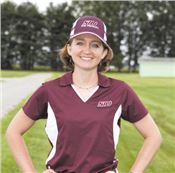|
Feeding Plants, Not Streams

Looking at late season nitrogen management in southern Illinois, is a project under study
by Dr. Rachael Cook, assistant professor of soil fertility at Southern Illinois University at Carbondale.
Photo by John LaRose, Jr.
Specialist Offers Tips To Manage Nitrogen, Protect Environment
BETTY VALLE GEGG-NAEGER
MidAmerica Farmer Grower
BELLEVILLE, ILL.
Nitrogen management in Southern Illinois is a project under study by Dr. Rachael Cook, assistant professor of soil fertility at Southern Illinois University at Carbondale.
“I have a project funded by the Illinois Nutrient Research Education Council,” she explained. “We’re looking at late season nitrogen management in southern Illinois, in hopes of improving our nitrogen management strategies due to issues with water quality. We have to get better at improving our environmental impact when it comes to nutrient management. This is a major environmental concern and it’s also important for the sustainability and profitability of farmers as well. So we’re trying to do a much better job of optimizing our nutrient strategies.”
One issue of the project is whether nitrogen can be managed better by applying it later in the season. Are there certain enhanced efficiency fertilizers that could be effective at improving yield and reducing environmental impact? Some things being considered are UAN versus urea with and without Agrotain, which is a urease inhibitor.
“We’re also looking at ESN which is a polymer coated fertilizer and we’re looking at timing, applying at planting versus treatments later,” Cook said. “One consideration is V4-V6 sidedress injection, and then also applications at V10; and now this year we’re also looking at VT. We’re taking soil samples to look at left-over residual nitrogen in the soil, considering whether there will be a long term environmental impact after the season, after harvest.”
Findings so far are from field sites at Dixon Springs, Belleville and Carbondale for the southern sites; there’s also cooperation with the University of Illinois on some central and northern Illinois sites that are replicating the study there.
“For us, last year, we found different results in different places as you might expect, because you have site conditions and you have weather conditions that are slightly different,” she said.
“The main take home that we found was that the urease inhibitors weren’t really necessary since we had enough rain. Urease inhibitors are generally more effective if it’s dry a week after urea broadcast application. We got enough rain so the urease inhibitors weren’t really necessary. We found that ESN, the polymer coated fertilizer did very well. It was put on broadcast at planting, with the same amount as everything else, and yielded the same as other N applications. The late season V10 urea applications also did very well, they were all essentially the same as at planting,” Cook reported.
“That tells us that some of these later season applications are fine,” she surmised. “It’s a reasonable way to manage your nitrogen. The one treatment that didn’t do quite as well was a UAN dribble application at V10. All the late application treatments got 50 pounds of N at planting and then 100 pounds at V10. The UAN dribble didn’t seem to do as well on a couple of locations. So we’ll see if the same pattern happens again this year.”
This will be a three-year project so the results may be a little different from year to year depending on site conditions and depending on weather. Because of that, Cook recommends farmers have some options for nutrient, nitrogen management strategies, depending on what works best for an individual.
“However, we’re trying to push more of the nitrogen on around the time when the plant is trying to take it up,” she said. “So when plants are very small at planting which is when people generally put on their nitrogen, the plant isn’t taking up very much nitrogen. They really start cranking and taking it up around V6 and they’re taking up a lot all the way up until V10, VT. That’s when we want to push more of the nitrogen on, when the plant is ready and taking it up.
“The trade off happens, such as this year if it starts raining right after planting and doesn’t stop, you may not be able to get in at V6 or even VT,” she explained. “That’s where something like ESN might provide a little more of an option, if you’re afraid it’s going to be rainy or you might not be able to get back in.
“We’re looking into these options, we’re trying to get some more information to give people some alternative management strategies that are better for the environment, and also, what may optimize your yield. Since this is a three-year project, we’ll have more studies coming, we have trials underway right now, and that about sums it up,” Cook said. ∆
BETTY VALLE GEGG-NAEGER: Senior Staff Writer, MidAmerica Farmer Grower
|
|